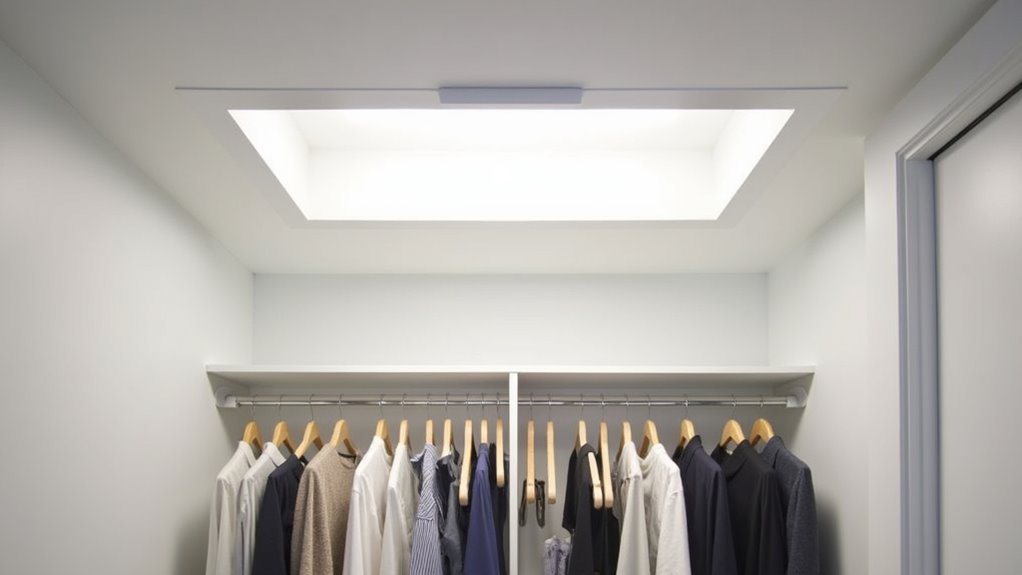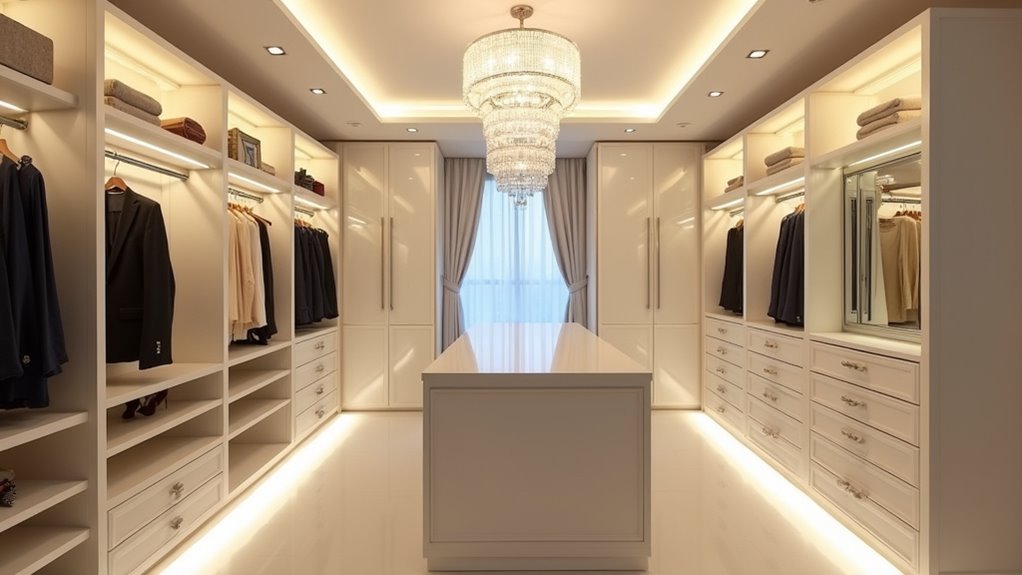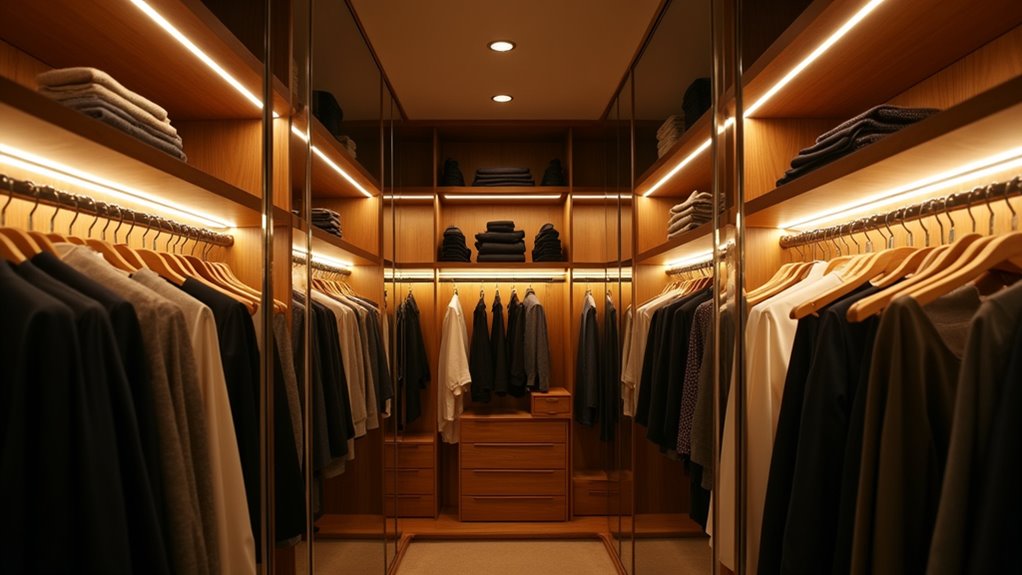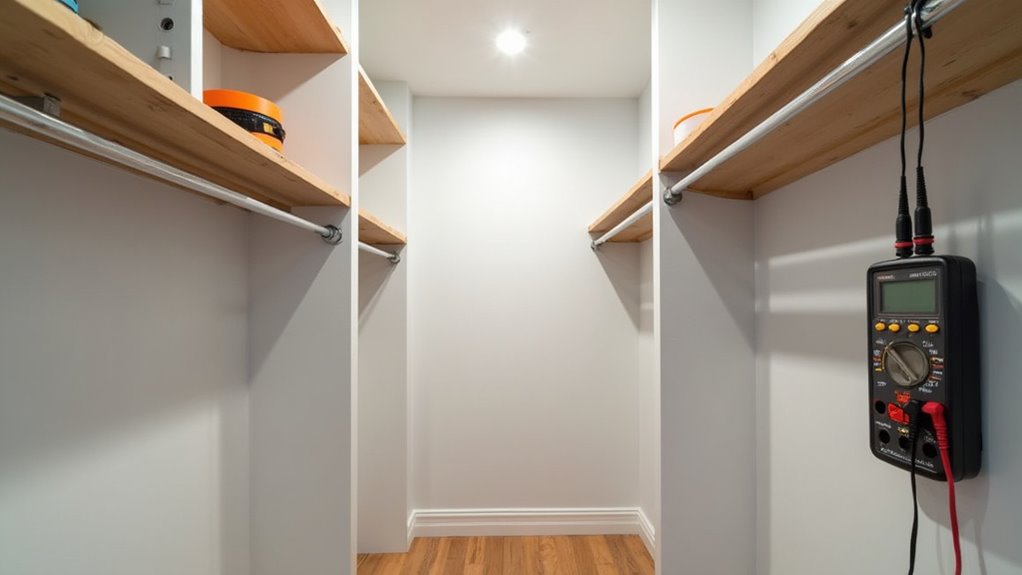Build custom storage shelves that stand the test of time by using heavy-gauge steel with powder-coated finishes or high-density sealed hardwood. You’ll need essential tools like a cordless drill, impact driver, and spirit level for precise assembly. Install cross-bracing between vertical supports and 90-degree corner brackets at junctions to handle up to 3,000 pounds per shelf. Proper reinforcement techniques and premium materials will guarantee your shelving system delivers decades of reliable service. The following detailed guide reveals advanced construction methods and critical safety considerations.
Selecting Premium Materials for Enduring Shelves
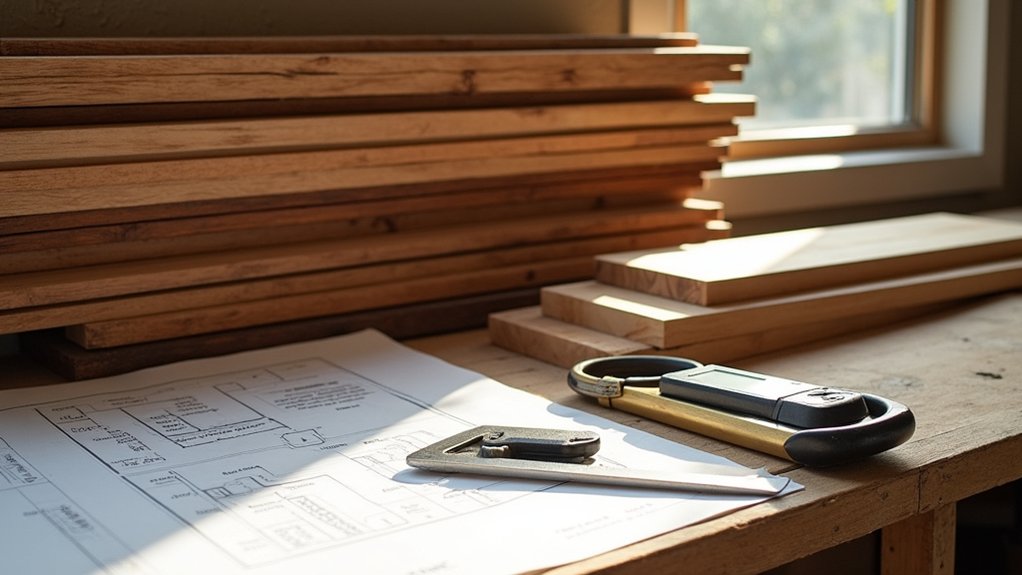
When building custom storage shelves that will stand the test of time, your choice of materials directly impacts their longevity and performance. Heavy-gauge steel offers exceptional material durability, supporting up to 3,000 pounds per shelf while resisting warping and denting. Its powder-coated finish prevents rust, making it ideal for workshops and industrial spaces. The double-layer steel columns provide enhanced structural integrity for maximum stability. During installation, be mindful of potential configuration errors that could compromise shelf stability. Modern storage solutions like the Heavy Duty Mega Rack demonstrate that 8000-pound capacity delivers industrial-grade performance for demanding applications.
For design aesthetics combined with strength, consider high-density plywood or hardwood options. You’ll get natural beauty and functional durability, especially when properly sealed for moisture resistance. If you’re prioritizing ventilation and easy maintenance, wire shelving systems provide robust support while preventing dust accumulation. For moderate loads with a polished look, laminated composites offer scratch resistance and clean surfaces. Whatever material you choose, make certain it matches your specific load requirements and environmental conditions.
Essential Tools and Equipment for Construction
To build professional-quality storage shelves, you’ll need a strategic mix of power tools like a circular saw, cordless drill, and impact driver to handle the core construction tasks efficiently. Your essential hand tools should include a quality tape measure, spirit level, stud finder, and combination square to guarantee precise measurements and proper installation. A cushioned grip trowel will be essential for applying any needed concrete patches or repairs during shelf installation. While investing in these tools, don’t overlook vital safety equipment such as safety glasses, hearing protection, and work gloves that protect you during every phase of construction. Choosing American-made tools will ensure accuracy and long-term dependability in your woodworking projects.
Power Tools Worth Investing
Building custom storage shelves requires a strategic investment in essential power tools that greatly enhance construction efficiency and precision. You’ll find significant investment benefits in three primary categories of power tools: cutting, drilling, and finishing equipment. A versatile impact driver system can provide the high-torque power needed for driving large fasteners and bolts into tough materials. Accurate measurements are critical, making a measuring tape an indispensable companion tool for any shelf-building project. A quality pneumatic nail gun paired with an appropriate air compressor can significantly speed up the assembly process.
| Tool Category | Primary Function | Investment Benefit |
|---|---|---|
| Cutting Tools | Material Sizing | Precise straight/curved cuts |
| Drilling Tools | Assembly/Mounting | Versatile material penetration |
| Finishing Tools | Surface Prep | Professional results |
Your core arsenal should include a quality cordless drill with adjustable torque settings for accurate assembly, a circular saw for straight cuts through lumber and sheet materials, and a random orbital sander for smooth finishing work. For advanced projects, consider adding a compound miter saw for precise angle cuts and an oscillating multi-tool for detail work in tight spaces.
Hand Tools You Need
Success in custom shelf construction begins with a well-organized collection of essential hand tools. You’ll need measuring and marking tools including a tape measure, carpenter’s square, and level to guarantee precise layout. For cutting, rely on a quality handsaw and backsaw, while utility knives handle detail work. Don’t overlook the hand tool benefits of reliable fastening tools like hammers, screwdrivers, and clamps.
For shaping and smoothing, keep files, sanding blocks, and chisels ready. Specialized tools such as a caulk gun, plumb bob, and adjustable wrench complete your arsenal. Similar to how security measures protect websites from threats, proper tool maintenance extends their lifespan – keep cutting tools sharp, measuring tools calibrated, and all tools clean and dry. Store them in a dedicated space where they’re protected yet easily accessible for your shelf-building projects.
Safety Equipment Essentials
When undertaking custom shelf construction, proper safety equipment serves as your essential defense against workplace hazards. You’ll need to prioritize protective measures starting with a Type I or Type II hard hat to guard against falling objects. Don’t forget ANSI Z87.1-rated safety glasses and a face shield when cutting or drilling materials. Quality leather gloves are vital as they provide cut-resistant protection when handling sharp materials and tools. Regular safety inspections of all tools and equipment before use helps prevent accidents and injuries. Wearing high visibility clothing with reflective strips ensures other workers can easily spot you during construction.
| Safety Gear | Protection Level |
|---|---|
| N95 Mask | Dust & Particles |
| Earplugs | Up to 85 dB |
| Steel-Toe Boots | Impact & Puncture |
For respiratory protection, you’ll want an N95-rated mask when cutting wood or working with particulates. If you’re operating power tools, hearing protection is vital; use earplugs or earmuffs when noise levels exceed 85 dB. Complete your safety gear with steel-toed boots featuring slip-resistant soles to prevent crushing injuries and falls.
Planning Your Custom Storage Layout
Before diving into your custom storage project, a thorough layout plan serves as the foundation for an efficient and scalable storage system. Start by measuring your available space, accounting for ceiling height and existing fixtures. You’ll need to subtract non-usable areas to determine your actual working volume. Narrow aisle designs can help achieve up to 30% more space utilization while maintaining efficiency.
Consider your inventory’s characteristics: types, sizes, weights, and turnover rates. Position frequently accessed items within easy reach and store heavier items on lower shelves. Plan aisle widths between 8′ to 12′ to guarantee safe equipment access while maximizing storage density. Implementing proper storage zone segmentation helps maintain organization and streamlines operations from receiving to shipping areas. Incorporating safety features into the design will minimize workplace accidents and improve overall worker well-being.
Create distinct zones for different storage needs and map out a logical workflow pattern. You’ll want to use design software or diagramming tools to visualize various configurations before implementation. This data-driven approach helps prevent costly layout adjustments later and guarantees your storage system meets both current and future needs.
Step-by-Step Assembly Guide
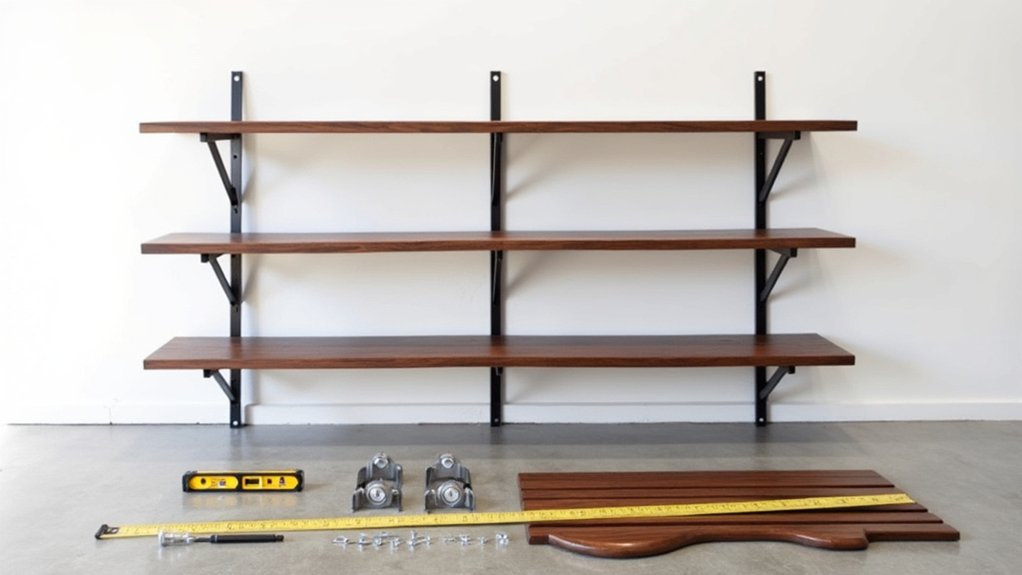
Building custom storage shelves starts with proper assembly techniques that transform your layout plans into reality. Begin by organizing all components and tools, including your rubber mallet, level, and screwdriver. Don your safety gear before proceeding with assembly.
Start constructing the foundation by connecting uprights to base beams, ensuring precise alignment according to your measurements. Install cross beams into keyhole slots, securing them firmly with your mallet. Ensure shelves are installed at 1-inch increments for maximum customization and organization flexibility. As you progress upward, add each shelf level systematically, checking for proper seating and alignment. Your custom shelving requires consistent tightening of fasteners throughout assembly.
Complete the process by verifying each connection, confirming level positioning, and installing safety components. Don’t forget to mark weight capacities clearly on each shelf to prevent future overloading and maintain your structure’s integrity.
Reinforcement Techniques for Maximum Stability
You’ll greatly enhance your shelf’s structural integrity by installing cross-bracing between vertical supports, which prevents lateral movement and distributes weight more evenly across the frame. Adding 90-degree corner brackets at each shelf junction creates essential triangulation that combats twisting forces and racking under load. These reinforcement techniques work together to transform a basic shelving unit into a robust storage system that can reliably handle heavy items while maintaining proper alignment.
Cross-Bracing Adds Vital Support
When structural integrity matters most, proper cross-bracing serves as the cornerstone of any reliable storage system. You’ll need to install these essential 12-gauge steel supports on end sections and every fourth section between them to guarantee maximum cross-bracing effectiveness.
Your shelving’s structural integrity depends on precise placement – attach lateral braces to the back of upright posts, while end braces bolt to the sides. Don’t skip anchoring uprights to the floor or wall, as this complements the bracing system’s stability. For enhanced safety, especially in seismic zones, you’ll want additional bracing as load capacity increases.
With proper cross-bracing, your shelves can safely handle 500 to 2,000 pounds per shelf while resisting lateral sway and buckling. Remember, skipping this critical step may void your warranty and compromise safety standards.
Corner Brackets Prevent Twisting
While cross-bracing forms the backbone of shelf stability, corner brackets serve as the essential joints that lock your structure into place. You’ll maximize corner bracket effectiveness by selecting steel L-shaped or triangular brackets, which distribute weight across both walls and prevent lateral movement. Install them 5-10cm from shelf edges for best load distribution.
| Bracket Type | Load Capacity | Best Application |
|---|---|---|
| Steel L-Shape | 200-250 lbs | Heavy-duty storage |
| Triangle | 150-200 lbs | Traditional builds |
| Concealed | 100-150 lbs | Decorative displays |
For superior shelf stability enhancements, anchor brackets directly into wall studs. Pre-drill pilot holes to prevent wood splitting, and avoid over-tightening screws. Regular inspection of bracket tightness guarantees long-term performance, while periodic finish touch-ups maintain both function and aesthetics.
Surface Treatment and Protective Finishes
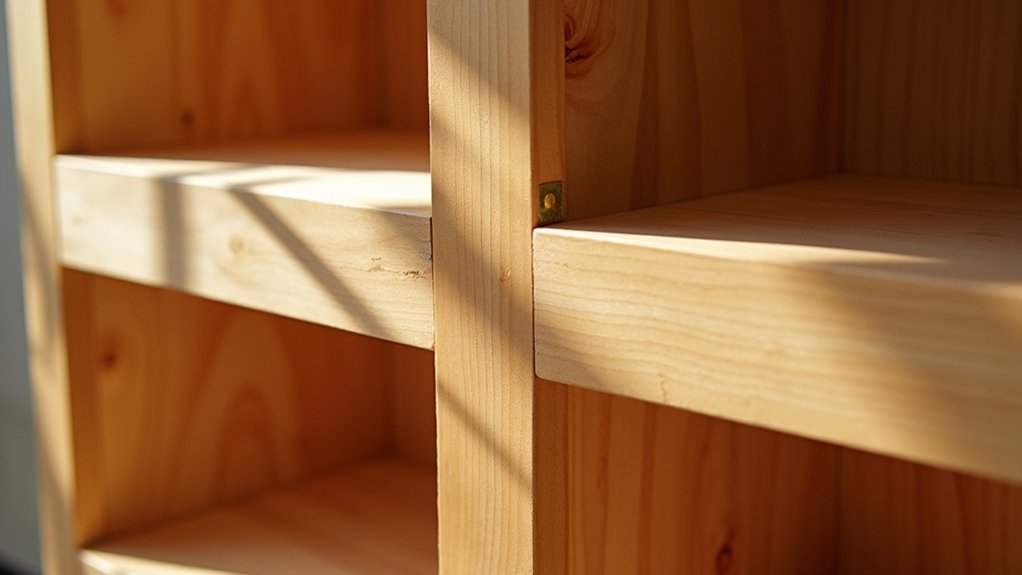
Protective finishes play an essential role in extending the lifespan and functionality of custom storage shelves. You’ll find several surface finishes to choose from, each offering distinct advantages for your storage needs.
Epoxy and powder coatings provide exceptional durability, with powder coats withstanding 250+ hours in salt spray tests. You can select from multiple colors to organize inventory or match your décor. If you’re working in humid environments, zinc coating offers superior rust protection through its sacrificial layer that shields the underlying steel.
For antimicrobial requirements, both epoxy and powder coatings come in specialized variants. Your shelves will receive these protective coatings through electrostatic spraying and high-temperature curing, ensuring maximum adhesion and long-term performance. All finishes undergo rigorous testing for scratch, impact, and corrosion resistance.
Advanced Features for Versatility
You’ll find significant advantages in modular storage systems that allow for seamless expansion and reconfiguration as your storage needs evolve. The ability to add, remove, or adjust components lets you customize the storage layout while maintaining structural integrity through load-bearing elements rated for specific weight capacities. Your storage solution’s versatility extends through compatible accessories like drawers, bins, and specialized compartments that integrate smoothly with the base framework.
Modular Storage System Benefits
Modern modular storage systems offer unprecedented versatility through their advanced features and adaptable design elements. You’ll find that these flexible storage solutions deliver significant modular design advantages, allowing you to expand and modify your setup as needs change without overhauling the entire system.
| Feature | Benefit |
|---|---|
| Customizable Components | Adapt to varying item sizes and types |
| Stackable Units | Maximize vertical space utilization |
| Replaceable Parts | Reduce maintenance costs and downtime |
| Easy Integration | Support future expansion needs |
You’ll appreciate how these systems optimize both horizontal and vertical space while maintaining accessibility. The modular approach enables incremental investment, letting you scale gradually while ensuring long-term operational efficiency. With enhanced organization capabilities, you’ll experience faster item retrieval and simplified inventory management, ultimately boosting your storage system’s overall productivity.
Adjustable Load-Bearing Components
Advanced load-bearing components revolutionize storage flexibility through sophisticated adjustment mechanisms and robust weight capacities. You’ll find bolt-free interlocking designs that let you adjust shelf height without tools, while wall-mounted standards with multiple slots enable infinite positioning options.
Your storage capacity expands greatly with these systems, as individual shelves can support anywhere from 100 lbs per bracket up to 2,650 lbs per shelf. Heavy-duty mega racks handle total loads of 8,000 lbs when you distribute weight evenly. The double-layer steel columns and reinforced ribs guarantee long-term structural integrity, while anti-corrosion coatings protect against environmental wear.
You can customize your setup with compatible brackets that accommodate various materials, from wood to aluminum, making it easy to adapt your storage as needs change.
Maintenance Tips for Decades of Use
Maintaining custom storage shelves properly can extend their lifespan well beyond 20 years. Start by implementing regular preventive maintenance and inspection schedules to catch wear before it becomes severe. You’ll need to check for cracks, dents, loose hardware, and corrosion monthly.
When you spot issues, address them immediately. Tighten loose fasteners, replace damaged components, and realign shelving that’s shifted out of level. Don’t forget to clean your shelves regularly; dust and grime can accelerate wear, especially on metal surfaces. Use mild detergent and soft cloths, ensuring thorough drying afterward.
Label maximum load capacities clearly and distribute weight evenly across shelves. Train everyone who uses the storage system to identify defects and report damage promptly. Document all maintenance activities, repairs, and safety checks for future reference.
Environmental Considerations and Sustainability
Beyond maintaining your shelves, understanding their environmental impact shapes responsible ownership. When selecting materials, prioritize sustainable sourcing through bamboo, reclaimed wood, or responsibly harvested hardwoods like oak and maple. These eco-friendly materials offer durability while minimizing environmental harm.
Choose steel or aluminum components for their high recyclability – aluminum recycling saves 95% of energy compared to new production. Opt for water-based finishes and nontoxic adhesives to reduce VOC emissions and improve indoor air quality. Avoid particleboard or MDF, which often contain harmful formaldehyde.
Design your shelves for eventual disassembly, selecting modular components that facilitate repairs or upgrades. This approach extends their lifespan and supports material circularity. When possible, source from manufacturers using renewable energy and clean production methods.
Cost Analysis: Long-Term Value Assessment
While custom storage shelves require a higher initial investment than pre-fabricated options, their long-term value often justifies the upfront costs. A detailed cost comparison reveals that custom solutions, though averaging $100-$400 per linear foot plus installation, deliver substantial investment benefits through durability and functionality.
- Professional installation with reinforced joints and premium materials greatly reduces replacement frequency and maintenance costs
- Tailored designs maximize spatial efficiency, particularly in challenging layouts where standard shelving wastes valuable space
- Custom features like adjustable heights and integrated lighting adapt to your changing storage needs without requiring system replacement
- Higher resale value potential, as home buyers view custom storage as a premium upgrade, often leading to increased property valuation
The long-term savings in maintenance, replacements, and property value appreciation typically offset the initial price difference between custom and pre-made options.
Frequently Asked Questions
Can Custom Storage Shelves Be Safely Installed on Uneven Concrete Floors?
Yes, you can safely install custom storage shelves on uneven concrete floors by implementing specific uneven surface solutions. Start by evaluating floor irregularities and use adjustable legs or permanent shims for proper leveling. Enhance shelf stability techniques by anchoring units to wall studs and creating a level platform base. For severely uneven floors, you’ll want to apply self-leveling compounds or seek professional concrete repair before installation.
How Do Extreme Temperature Fluctuations Affect the Longevity of Storage Shelves?
Temperature fluctuations greatly reduce your shelf’s lifespan. To maximize temperature resilience, you’ll need careful material selection. Wood and plastic will warp and crack from expansion/contraction cycles, while metal joints can weaken in cold conditions. You’ll find that high heat breaks down adhesives and protective finishes, while cold makes materials brittle. Keep your shelves in climate-controlled spaces between 60-77°F (15-25°C) to prevent these issues.
What Insurance Considerations Should Be Made When Installing Heavy-Duty Storage Systems?
You’ll need thorough liability coverage that specifically addresses installation risks when implementing heavy-duty storage systems. Make certain your policy includes protection against property damage, worker injuries, and equipment breakdown. You should also secure bailee insurance if you’re storing customer goods. Don’t forget to verify that your coverage meets local regulations and includes defense against legal claims. Regular safety inspections and maintenance documentation can help reduce your premiums.
Are Building Permits Required for Floor-To-Ceiling Custom Storage Installations?
Yes, you’ll typically need a building permit for floor-to-ceiling storage installations, especially those exceeding 5′ 9″ in height. Local building codes often require permits for significant structural modifications that impact space safety. You’ll need to submit detailed designs and documentation to authorities before beginning your installation. While some jurisdictions offer exemptions for small-scale projects, installation regulations generally mandate permits for large, heavy-duty storage systems that extend from floor to ceiling.
How Do Different Lighting Conditions Impact the Visibility of Stored Items?
You’ll find that lighting placement dramatically affects how well you can see your stored items. Under-shelf lighting eliminates shadows and provides even illumination, while over-shelf lighting creates depth through shadow effects. Ambient light from the rear offers a backlit effect, making items more distinct. For peak visibility, you’ll want to combine lighting positions and use bright, cool-white LEDs rather than relying on a single light source.

